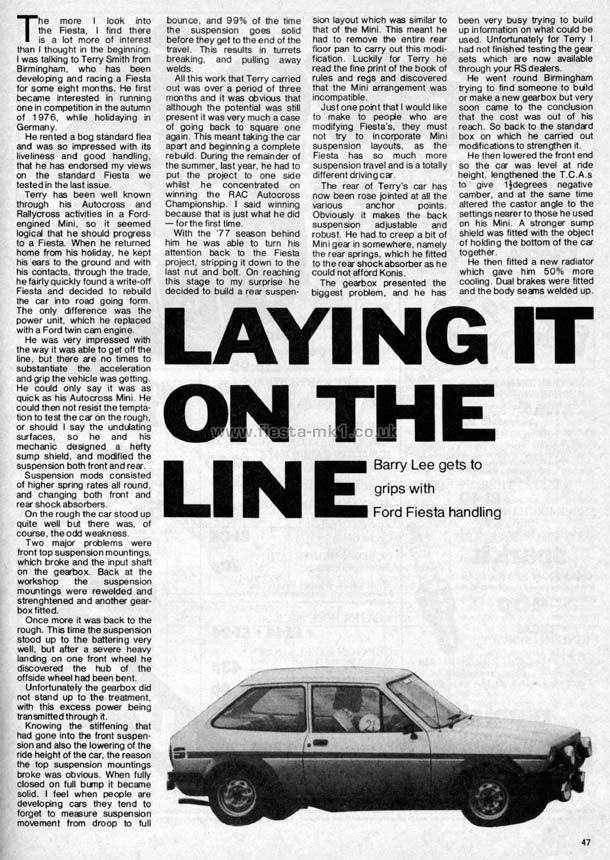Copy of Article Text Below
Laying it on The Line
Barry Lee gets to grips with Ford Fiesta handling
The more I look ”nto the Fiesta, I find there is a lot more of ”nterest than I thought in the beginning. I was talking to Terry Smith from Birmingham, who has been develo ping and racing a Fiesta for some eight months. He first became interested in running one in competition in the autumn of 1976, while holidaying in Germany.
He rented a bog standard flea and was so impressed with its liveliness and good handling, that he has endorsed my views on the standard Fiesta we tested in the last issue.
Terry has been well known through his Autocross and Rallycross activities in a Ford-engined Mini, so it seemed logica! that he should progress to a Fiesta. When he returned home from his holiday, he kept his ears to the ground and with his contacts, through the trade, he fairly quickly found a write-off Fiesta and decided to rebuild the car into road going form. The only difference was the power unit, which he replaced with a Ford twin cam engine.
He was very impressed with the way it was able to get off the line, but there are no times to substantiate the acceleration and grip the vehicle was getting. He could only say it was as quick as his Autocross Mini. He could then not resist the tempta-tion to test the car on the rough, or should I say the undulating surfaces, so he and his mechanic designed a hefty sump shield, and modified the suspension both front and rear.
Suspension mods consisted of higher spring rates all round, and changing both front and rear shock absorbers.
On the rough the car stood up quite well but there was, of course, theodd weakness.
Two major problems were front top suspension mountings, which broke and the input shaft on the gearbox. Back at the workshop the suspension mountings were rewelded and strenghtened and another gearbox f itted.
Once more it was back to the rough. This time the suspension stood up to the battering very well, but after a severe heavy landing on one front wheel he discovered the hub of the offside wheel had been bent.
Unfortunately the gearbox did not stand up to the treatment, with this excess power being transmitted through it.
Knowing the stiffening that had gone into the front suspension and also the lowering of the ride height of the car, the reason the top suspension mountings broke was obvious. When fully closed on full bump it became solid. I feel when people are developing cars they tend to forget to measure suspension movement from droop to full bounce, and 99% of the time the suspension goes solid before they get to the end of the travel. This results in turrets breaking, and pulling away welds.
All this work that Terry carried out was over a period of three months and it was obvious that although the potential was still present it was very much a case of going back to square one again. This meant taking the car apart and beginning a complete rebuild. During the remainder of the summer, last year, he had to put the project to one side whilst he concentrated on winning the RAC Autocross Championship. I said winning because that is just what he did - for the first time.
With the '77 season behind him he was able to turn his attention back to the Fiesta project, stripping it down to the last nut and bolt. On reaching this stage to my surprise he decided to build a rear suspension layout which was similar to that of the Mini. This meant he had to remove the entire rear floor pan to carry out this modifica tion. Luckily for Terry he read the fine print of the book of rules and regs and discovered that the Mini arrangement was incompatible.
Just one point that I would like to make to people who are modifying Fiesta's, they must not try to incorporate Mini suspension layouts, as the Fiesta has so much more suspension travel and is a totally different drivingcar.
The rear of Terry's car has now been rose jointed at all the various anchor points. Obviously it makes the back suspension adjustable and robust. He had to creep a bit of Mini gear in somewhere, namely the rear springs, which he fitted to the rear shockabsorber as he could not afford Konis.
The gearbox presented the biggest problem, and he has been very busy trying to build up information on what could be used. Unfortunately for Terry I had not finished testing the gear sets which are now available through your RSdealers.
He went round Birmingham trying to find someone to build or make a new gearbox but very soon carne to the conclusion that the cost was out of his reach. So back to the standard box on which he carried out modificationsto strengthen it.
He then lowered the front end so the car was level at ride height, lengthened the T.C.A.s to give Ijdegrees negative camber, and at the same time altered the castor angle to the settings nearer to those he used on his Mini. A stronger sump shield was fitted with the object of holding the bottom of the car together.
He then fitted a new radiator which gave him 50% more cooling. Dual brakes were fitted and the body seams welded up......
|



